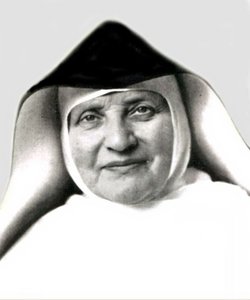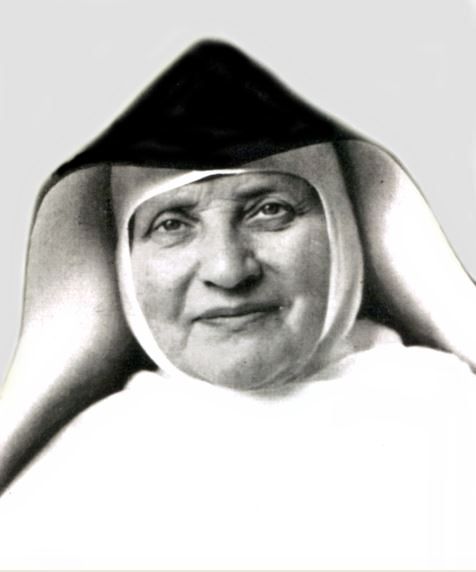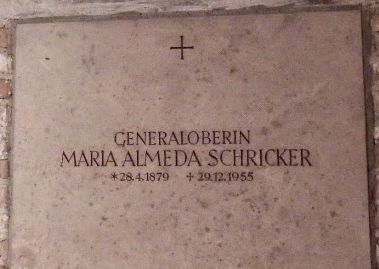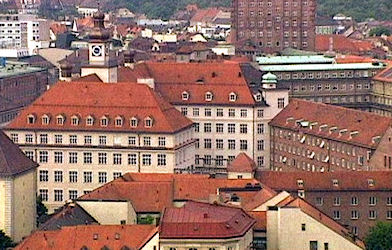Erste Profess 1903
Hauptmutterhaus
München, Deutschland
Generaloberin
Arme Schulschwestern v.U.L.Fr.
School Sisters of Notre Dame
Hauptmutterhaus
München, Deutschland
1928 bis 1955
Mother M. Almeda was the 6th General Superior of the School Sisters of Notre Dame. She was the first General Superior who had never known the foundress Blessed Theresia Gerhardinger, and the last General Superior to be elected for life. With her passing, an era came to an end.
Mother Almeda was preceded in office by Mother M. Bruno Thoma, who had resigned as Superior General due to age -- she was 82 at her resignation.
When Adolf Hitler came into power, he set about restricting the influence of the Catholic Church, with the ultimate goal of eliminating it entirely in the Third Reich. Sisters were forced from the classrooms. Quota restrictions were placed on Candidates accepted to the Novitiate, and Novices professing First Vows. Mother Almeda offered Sisters the opportunity to go to the Americas if they wished, as she could not assure them they would be allowed by the government to live out their religious vocation in Hitler's Europe.
The years of the Second World War were difficult. In December 1944, the Angerkloster (the "Hauptmutterhaus" or "Main Motherhouse") took a direct hit during the Allied bombing of Munich. Miraculously, none of the Sisters were killed. Communication with the Sisters of North America was impossible. As the war progressed, terrible poverty beset the peoples of Europe. Many of the Sisters were caught between the Armies of the Third Reich and the Soviet Union, suffering terrible outrages at the hands of both. Numbers of Sisters became refugees. Some were interred in concentration camps. At least one died as a result of her treatment in the camps.
As Communism advanced in Eastern Europe, Sisters in those countries were restricted in their ministry by the government. The Sisters of Romania were cut off completely from the rest of the world. (It would not be until the détente of the Nixon Administration that the Superior General and the rest of the Congregation would know for certain if there even were still SSNDs in Romania.) The Sisters of Czechoslovakia were forced underground.
Following Mother Almeda's death in 1955 the Congregation was led by the Vicar General Sister M. Bettina Schaidl while preparations were made for the 1956 General Chapter and the election of a new General Superior. This time the delegates elected an American, Mother M. Ambrosia Roecklein.
(SSND Archives)
Christus sei ihr ewige Freude und Erfüllung!
Erste Profess 1903
Hauptmutterhaus
München, Deutschland
Generaloberin
Arme Schulschwestern v.U.L.Fr.
School Sisters of Notre Dame
Hauptmutterhaus
München, Deutschland
1928 bis 1955
Mother M. Almeda was the 6th General Superior of the School Sisters of Notre Dame. She was the first General Superior who had never known the foundress Blessed Theresia Gerhardinger, and the last General Superior to be elected for life. With her passing, an era came to an end.
Mother Almeda was preceded in office by Mother M. Bruno Thoma, who had resigned as Superior General due to age -- she was 82 at her resignation.
When Adolf Hitler came into power, he set about restricting the influence of the Catholic Church, with the ultimate goal of eliminating it entirely in the Third Reich. Sisters were forced from the classrooms. Quota restrictions were placed on Candidates accepted to the Novitiate, and Novices professing First Vows. Mother Almeda offered Sisters the opportunity to go to the Americas if they wished, as she could not assure them they would be allowed by the government to live out their religious vocation in Hitler's Europe.
The years of the Second World War were difficult. In December 1944, the Angerkloster (the "Hauptmutterhaus" or "Main Motherhouse") took a direct hit during the Allied bombing of Munich. Miraculously, none of the Sisters were killed. Communication with the Sisters of North America was impossible. As the war progressed, terrible poverty beset the peoples of Europe. Many of the Sisters were caught between the Armies of the Third Reich and the Soviet Union, suffering terrible outrages at the hands of both. Numbers of Sisters became refugees. Some were interred in concentration camps. At least one died as a result of her treatment in the camps.
As Communism advanced in Eastern Europe, Sisters in those countries were restricted in their ministry by the government. The Sisters of Romania were cut off completely from the rest of the world. (It would not be until the détente of the Nixon Administration that the Superior General and the rest of the Congregation would know for certain if there even were still SSNDs in Romania.) The Sisters of Czechoslovakia were forced underground.
Following Mother Almeda's death in 1955 the Congregation was led by the Vicar General Sister M. Bettina Schaidl while preparations were made for the 1956 General Chapter and the election of a new General Superior. This time the delegates elected an American, Mother M. Ambrosia Roecklein.
(SSND Archives)
Christus sei ihr ewige Freude und Erfüllung!




